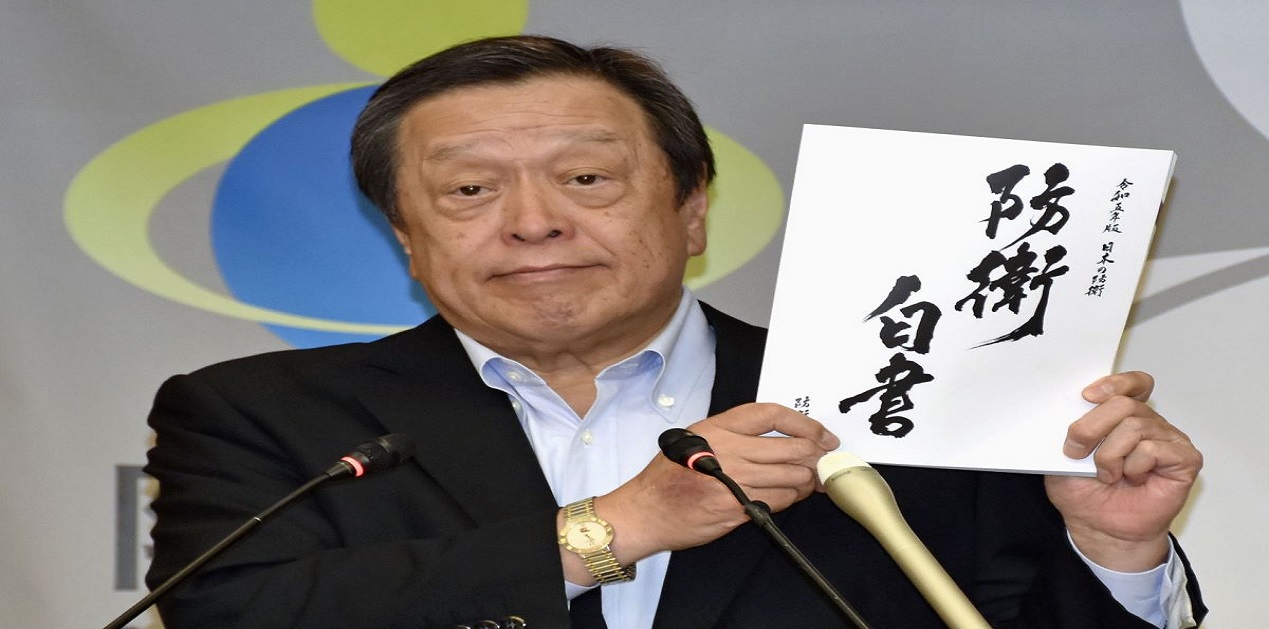The Japanese government released the 2023 Defense Paper[1] in July, at a time when Japan finds itself in the midst of an era of crisis, facing its most severe and complex security environment since World War II. This year’s edition is different than from previous years as it is the first White Paper since Japan adopted three basic security documents: National Security Strategy[2], National Defense Strategy.[3] and Defense Force Development Plan.[4] These three documents explain in detail the measure that Japan needs to take to strengthen its defence capabilities.
What are the key points underling the three documents? The main key point of the three documents reflected in the White Paper is the recommendation to the government to acquire a counter-strike capability as insurance to deter any invasion against Japan. This also includes acquiring missile defence system to prevent use of force by another country. What triggered Japan to include such provisions in the White Paper was Russia’s military operation against Ukraine as it proved the hypothesis that a country in possession of a strong military capability would be tempted one day to use it against another country, which is why it dawned on Japan to adequately equip itself for deterring an enemy attack.
The White Paper also called for a shift to a threat-response defence force structure. This includes substantial hike in defence expenditure to over $300 billion in next five years from fiscal 2023. Of this, $14 billion is to be earmarked for ammunition and guided missiles and another $7 billion for an unmanned assets defence capability.[5]
Acquiring 400 Tomahawk Missiles from the US
What is significant to note was that even before the release of the White Paper but after the release of the three key defence documents, in a surprise move Prime Minister Fumio Kishida announced plans to bulk-order 400 Tomahawk, also known as TLAMS, cruise missiles from the US in fiscal 2023, starting in April, as part of his government’s plan to bolster the counter-strike capability of the Japan Self-Defense Forces (JSDF).[6]The deployment of the missiles on Aegis-equipped destroyers will add to Japan’s counter-strike capability. Kishida’s announcement came as a surprise because the MoD normally does not officially disclose the number of missiles held or acquired by the JSDF. However, Kishida did not reveal the unit price or the number of missiles in possession of the JSDF as he did not want to reveal the war-fighting sustainability of the SDF. However, Kishida felt that the people deserve to know the number missiles that Japan plans to buy from the US.
Japan’s Minister of Defense Minoru Kihara who assumed office on 13 September amid a Cabinet reshuffle underlined the severe security environment and rapidly escalating regional threats and resolved to strengthen SDF’s stand-alone defence capabilities to deter and eliminate the invasion force into Japan at an early and distant stage. Minoru also stressed that as a part of the effort, the MoD will also consider to acquire domestically produced stand-alone missiles at an earlier date.[7]
As per plans, the MoD shall enter into a contract with Raytheon Technologies Corp to acquire Tomahawk through the US government’s Foreign Military Sales (FMS) program during the current fiscal year. The MoD plans to deploy the Tomahawks in fiscal 2026-27 and expected to acquire the latest model Tomahawk Block V to be equipped onto Japan Maritime Self Defense Force (JMSDF) Aegis-equipped destroyers.
Tomahawk is not as stealthy or fast as some modern successors. But it has been heavily improved over the years. The Block IV model can now transmit video imagery while travelling to target, perform manoeuvres to evade defences while in transit, loiter overhead waiting for a signal to attack, and can be retargeted or instructed to abort the attack midflight—options that might reassure Japanese officials.
The latest Block V model re-introduces anti-ship capability in a sub-variant called the Block Va Maritime Strike Tomahawk. This integrates a radar seeker that enables it to home in on moving ships. There is also a Block Vb with an advanced JMEWS warhead capable of bunker-busting penetrating strikes on underground missile silos and WMD facilities.
According to Janes Weapons, Tomahawk is a submarine- and surface-launched subsonic land-attack cruise missile with inertial navigation system (INS) guidance. The missile, produced by Raytheon, is capable of hitting moving targets with multimode and mid-course guidance. The range of the Tomahawk, depending on versions of the missile, varies from 550 to 2,500 km. The most recent versions of the missile – designated Block IV – are integrated with a data-link to enable the switching of targets while in flight and are capable of loitering for “prolonged duration”.
The decision to acquire about 400 Tomahawk was under planning since last year in November. Citing government source, Japan's Kyodo news agency had reported on 30 November 2022 that the MoD is considering the acquisition of “about 500” Tomahawk missiles from the US between 2023 and 2027. Having made the announcement now, Japan would be the first user of the system outside the UK and US. Navies in these countries use the weapon on a range of surface and subsurface combatants.[8] As the only foreign operator, UK deploys the Tomahawk in its Royal Navy submarines. There are reports that Canadian CSC frigates and Australian Hobart-class destroyers are also planning to eventually deploy these long-range attack weapons.
In fact Japan has seen a steady deterioration in the security environment in its neighbourhood. Japan had been trying to buy such weapons for years but lack of political will and fear of public disapproval delayed the government’s decision. It required Kishida’s bold stand that finally made this possible. Japan has been feeling threatened for some time by China and North Korea’s large arsenals of land-based missiles. This decision is a part of the large increase in Japanese defence spending, which shall include more naval platforms.[9]
Japan has to make its choice of launch platforms, i.e. a combination/mix of air, sea, submarine and land-based options. Sebastien Roblin writes: “The cheapest option would be land-based trucks, but warships and aircraft would effectively expand the range and possible approach vectors of Japan’s Tomahawks. Presently, reports suggest they’ll begin deployment on Japan’s powerful destroyers, which already come with the same Mark 41 Vertical Launch Systems used by U.S. Navy ships to launch Tomahawks and many other types of missiles.”[10]He elaborates further, saying that Japan’s military might build a ‘test boat’ to study equipping Japanese submarines to fire Tomahawks.
Roadblocks
Kishida government could face formidable roadblocks in its efforts to beef up Japan’s defence capability. There are two reasons: Japan’s armed forces are legally forbidden from using force outside of self-defence of Japanese soil, even in event of an attack on nearby allies. Post-War governments have therefore avoided procuring weapons systems like aircraft carriers deemed to have mostly offensive weapons. The increasing tensions with North Korea over frequent missile launches and China’s military threat have changed Japan’s security outlook. As a result, Japan has planned to beef up its own security on the premise that offense is the best form of defence.
Japan is cognizant of the fact that China and North Korea possess large arsenals of land-based ballistic missiles (and cruise missiles and hypersonic glide vehicles). Both these neighbouring countries can unleash missile power to destructive effect in the event of a high-intensity conflict. If the US comes into conflict either with North Korea or China or both, Japanese airbases hosting US military aircraft would come under attack. Such a scenario might compel Japan to retaliate militarily. In such an eventuality, public opinion shall be sharply divided as the peace-loving Japanese people would abhor seeing their country return to the militaristic past and get embroiled in a military conflict.
The other reason is the Japanese media that shapes public opinion with their positions is unlikely to take a common stand on the government’s decision. For example, the influential Asahi Shimbun does acknowledge that China presents the biggest strategic challenge now because of its aggressive stance on the regional issues. It finds flaws that the nuclear deterrence issue was not articulated clearly in the Defence White Paper and wished this should have been given separate treatment.[11]> The editorial also notes that the Kishida administration was found wanting in its lack of an exhaustive explanation to the public on what the country’s defence agenda would be for the future.
On the other hand, the right-leaning Sankei group English daily Japan Forward complimented the three security documents as Kishida’s commitment to fulfil his duty to the people of the country. In an editorial, it applauded Kishida’s decision and cooperation with the ruling coalition partner Komeito in deciding on measures to fundamentally strengthen defence capabilities. It further observed that this was something that even Abe administration was unable to achieve.[12] Thus whichever ways one sees whether the glass is half full or half empty, Kishida’s dilemma would be arduous as such sensitive defence issues could have bearing on the entire population of the country and Kishida would need their unstinted endorsement. That remains a million dollar question for which there is no easy answer.
References
[1] “Defense of Japan 2023”, https://www.mod.go.jp/en/publ/w_paper/wp2023/DOJ2023_Digest_EN.pdf
[2] “National Security Strategy of Japan”, December 2022, https://www.cas.go.jp/jp/siryou/221216anzenhoshou/nss-e.pdf
[3] “Japan's National Security Strategy a Fulfillment of Duty to Its People”, Japan Forward, editorial, 19 December 2022, https://japan-forward.com/editorial-japans-national-security-strategy-a-fulfillment-of-duty-to-its-people/
[4] “Defense Build-up Program”, 16 December 2022, https://www.mod.go.jp/j/approach/agenda/guideline/plan/pdf/program_en.pdf
[5] “The New Defense White Paper is Out; Now Get the Public On Board”, Japan Forward, editorial, 3 August 2023, https://japan-forward.com/editorial-the-new-defense-white-paper-is-out-now-get-the-public-on-board/
[6]Takahashi Kosuke, “PM Kishida Announces Japan Will Acquire 400 Tomahawk Missiles From US”, The Diplomat, 28 February 2023, https://thediplomat.com/2023/02/pm-kishida-announces-japan-will-acquire-400-tomahawk-missiles-from-us/#:
[7] Ridzwan Rahmat, “Japan accelerates stand-off missile programmes amid tense security environment”, 5 October 2023, https://www.janes.com/defence-news/weapons-headlines/latest/japan-accelerates-stand-off-missile-programmes-amid-tense-security-environment
[8]Jon Grevatt, “Japan weighs up Tomahawk missile procurement”, 1 December 2022, https://www.janes.com/defence-news/news-detail/japan-weighs-up-tomahawk-missile-procurement
[9]Sebastien Roblin, “The U.S. Finally Sold 400 Tomahawk Missiles to Japan. Here’s Why”, 28 February 2023, https://www.popularmechanics.com/military/weapons/a43105819/us-sells-japan-tomahawk-missiles/
[10]Ibid.
[11] “Japan’s race to gain enemy strike capability is unacceptable”, Asahi Shimbun, editorial, 9 October 2023, https://japan-forward.com/editorial-the-new-defense-white-paper-is-out-now-get-the-public-on-board/
[12] “Japan's National Security Strategy a Fulfillment of Duty to Its People”, Japan Forward, editorial, 19 December 2022, https://japan-forward.com/editorial-japans-national-security-strategy-a-fulfillment-of-duty-to-its-people/
(The paper is the author’s individual scholastic articulation. The author certifies that the article/paper is original in content, unpublished and it has not been submitted for publication/web upload elsewhere, and that the facts and figures quoted are duly referenced, as needed, and are believed to be correct). (The paper does not necessarily represent the organisational stance... More >>
Image Source: https://japan-forward.com/wp-content/uploads/2023/08/Defense-White-Paper-Hamada-20230728-Trim.jpg










Post new comment